
首先采用冷等静压-烧结的方法制备了两种不同纯度的钨板坯(纯钨和掺杂钨),掺杂钨的设计方法是将微量杂质粉末(石墨粉、氧化钨粉、KNO3粉等)混合到商用纯钨粉中。随后进行单向轧制,取样90%形变量的轧板。试样从轧制板材上切割下来,并在管式炉内进行不同温度退火(1100–1500◦C),管式炉中通入高纯氩气进行保护。对于每个轧制压下板,在TD视图(垂直于横向的平面)中进行观察。对EBSD样品进行机械抛光,然后在环境温度下用2.0 wt%NaOH水溶液在5.0 V下进行电解抛光。然后通过HKL Channel 5软件进行晶粒尺寸、织构分析。使用电感耦合等离子体质谱仪(ICP-MS 7700,Aligent有限公司)对退火前后的轧板进行杂质分析。
First, two tungsten slabs with different purity (pure tungsten and doped tungsten) were prepared by the cold isostatic pressing-sintering method. Etc.) mixed into commercial pure tungsten powder. Then, one-way rolling is carried out, and the rolled plate with 90% deformation amount is sampled. The sample was cut from the rolled plate and annealed at different temperatures (1100–1500 ◦C) in a tube furnace, and high-purity argon gas was introduced into the tube furnace for protection. For each rolling reduction plate, observe in the TD view (a plane perpendicular to the transverse direction). The EBSD samples were mechanically polished and then electrolytically polished at 5.0 V with a 2.0 wt% NaOH aqueous solution at ambient temperature. Then through HKL Channel 5 software for grain size and texture analysis. An inductively coupled plasma mass spectrometer (ICP-MS 7700, Aligent Co., Ltd.) was used to analyze the impurities before and after annealing.